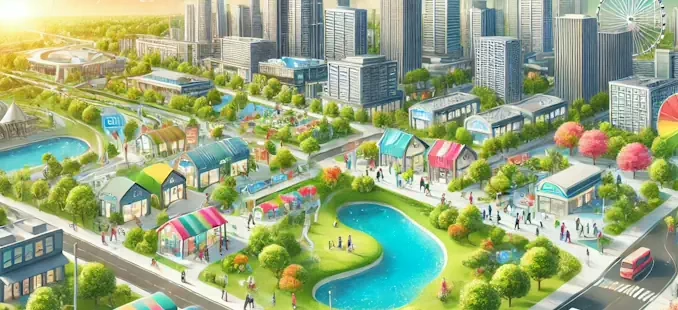
The 15-minute city, a concept that has gained significant attention in recent years, evokes diverse reactions. The idea is simple yet powerful: all essential amenities should be reachable within a 15-minute walk or bike ride. This urban planning model promises to enhance sustainability, quality of life, and social cohesion. But what are the historical roots of this concept? How is it applied today? And why does it provoke controversy? Let’s explore these questions in detail.
The Historical Roots of the 15-Minute City
The idea of a city where everything is nearby is not new. In medieval times, cities were often compact, with markets, churches, and workshops within walking distance. This was not deliberate urban planning but a practical necessity, as transportation was limited.
In the 19th century, this changed with the industrial revolution. Cities expanded rapidly, and suburbanization increased with the advent of trams and trains. The idea of compact urban living gave way to segregated residential and work areas. However, there were already thinkers like Ebenezer Howard advocating for the “garden city,” combining urban and rural qualities with amenities close at hand.
The modern concept of the 15-minute city is strongly rooted in the theories of Franco-Colombian urban planner Carlos Moreno. He introduced this idea in response to the challenges of large-scale urban development: traffic congestion, pollution, and a lack of connection between residents and their environment.
The Concept in the 21st Century
The 15-minute city has experienced a revival in the era of climate change, social inequality, and pandemics. It offers solutions to multiple challenges:
- Sustainability: Reduced reliance on cars decreases greenhouse gas emissions.
- Health: Increased walking and cycling improve physical and mental health.
- Social Cohesion: Local interactions foster a sense of community.
Cities like Paris and Melbourne have embraced the concept. In Paris, Mayor Anne Hidalgo has made the 15-minute city a cornerstone of her policies. Bike paths have been expanded, streets made car-free, and neighborhood amenities such as schools and health centers improved.
Controversies and Criticism
Although the concept offers many benefits, it also faces resistance. Here are some of the most common critiques:
1. Restriction of Individual Freedom
Critics fear that the 15-minute city could lead to a form of “urban feudalism,” where residents are “trapped” in a small area. While the idea is not to restrict travel beyond the neighborhood, some perceive it as a threat to their freedom of movement.
2. Gentrification and Social Exclusion
Improving neighborhood amenities can unintentionally drive up property values and rents, potentially displacing lower-income groups. Ironically, a concept aiming for inclusivity might lead to exclusivity.
3. Distrust and Conspiracy Theories
Some groups have associated the 15-minute city with dystopian visions where governments control citizens’ mobility. These conspiracy theories often stem from a misunderstanding of the concept but still influence public perception.
Different Perspectives on the 15-Minute City
The debate around the 15-minute city reveals diverse viewpoints:
Supporters
- Environmental Activists: See it as a way to make cities more sustainable.
- Health Organizations: Highlight the positive effects on physical activity and social health.
- Municipal Governments: View it as an opportunity to make their cities more livable and attractive.
Opponents
- Transport Lobbies: Argue that car traffic remains essential for economic activity.
- Libertarian Thinkers: Warn against government interference and potential restrictions on individual freedom.
- Local Residents: Some fear that changes will make their neighborhood less affordable.
The Future of the 15-Minute City
The coming years will be crucial for the further implementation of the concept. Cities must balance ambition with realism. This requires:
- Inclusive Policies: Ensure that gentrification is prevented and amenities remain accessible to all income groups.
- Communication: Take the time to inform and involve residents in decision-making.
- Flexibility: The concept must be adaptable to local circumstances and needs.
The 15-minute city has the potential to be a powerful driver of positive change. However, challenges and criticisms should not be ignored.
Conclusion The 15-minute city is more than a buzzword in urban planning. It offers an opportunity to make cities more sustainable, healthier, and socially connected. But as with any ambitious idea, success depends on careful execution and the ability to reconcile different perspectives and interests. By learning from history, addressing concerns, and focusing on inclusivity, the 15-minute city can become more than a utopia—it can be the reality of a better urban future.
Copyright text & image: devrijmetselaar.nl
Texts are based on the ideas and content of the author of devrijmetselaar.nl, reviewed, corrected, and supplemented with the assistance of OpenAI. Images are created based on the ideas of the author of devrijmetselaar.nl using OpenAI/DALL-E.

Be the first to comment